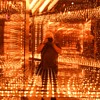Posted 9 years ago
 rniederman
rniederman
(348 items)
The early 1900s was an awkward time in which a significant photographic technology transition was taking place and camera marketing strategies had to change. For companies that could adapt, the prize was a large amateur photographer market ready to use cheaper roll film instead of laborious glass plates.
Given that Kodak made roll film popular back in 1888 and continued putting significant marketing muscle into roll film technology (after all, Eastman owned nearly all of the roll film patents), other major makers could not ignore the trend and looked at ways of bridging the gap between roll film and glass plates. And for a brief period, new designs called ‘combination’ cameras were created and sold; ‘hybrid’ apparatus straddling the past (glass plates) while accommodating the future (roll film).
Sound familiar?
Conceptually, ‘combination’ cameras can be thought of as early 20th century versions of hybrid cars; products bridging the past (gasoline) and future (electricity). The belief was that a photographer would buy one camera for both worlds (roll film and plates). Unfortunately combination cameras were extremely clumsy to use and visually quite strange - especially when set up to use the ground glass as a composing and critical focusing aid. Owing to the scarcity of combination cameras, the important amateur photographer market must not have embraced the "one-camera / both worlds" concept.
Shown here is Thomas Blair's second attempt to produce a ‘combination’ camera; it is the successor to the Focusing Weno Hawk-eye, 1902-03. (FWIW, I sold this camera many years back.) Blair’s attempts were the first self-casing, folding-bellows outfits that did not require the roll film back to be removed. Although primarily roll film cameras, they could convert to glass plates midway through a roll of film or use the ground glass as a precision roll film focusing aid without having to swap backs (or external roll film carriers).
The June 1904 advertisement shown illustrates two views of the Combination Hawk-Eye: opened and closed. When the back is rotated upward, a ground glass back must be attached to the camera. What is not shown or described in the advertisement, is the fact that the ground glass assembly must first be removed from the camera body before closing the roll film back.
The Blair No.3 Combination Hawk-eye Camera sold for $27.50 in 1904 (about $792.15 in year 2019 currency).


























very nice!!!!!!!!!
Fascinating piece.
Thanks, Sean!
Thanks, AnnaB!
Your very welcome Rob!!!
Thanks, Michael!
Thanks, Brunswick!
Thanks, Manikin!
Thanks, blunderbuss2!
Thanks, David!
Thanks, Radegunder!
Thanks!
gargoylecollector
racer4four
vetraio50
fortapache
Thanks!
toolate2
f64imager
SpiritBear
Thanks!
Trey
GeodeJem
Thanks, shughs!
Thanks, NevadaBlades!
Thanks, pops52!